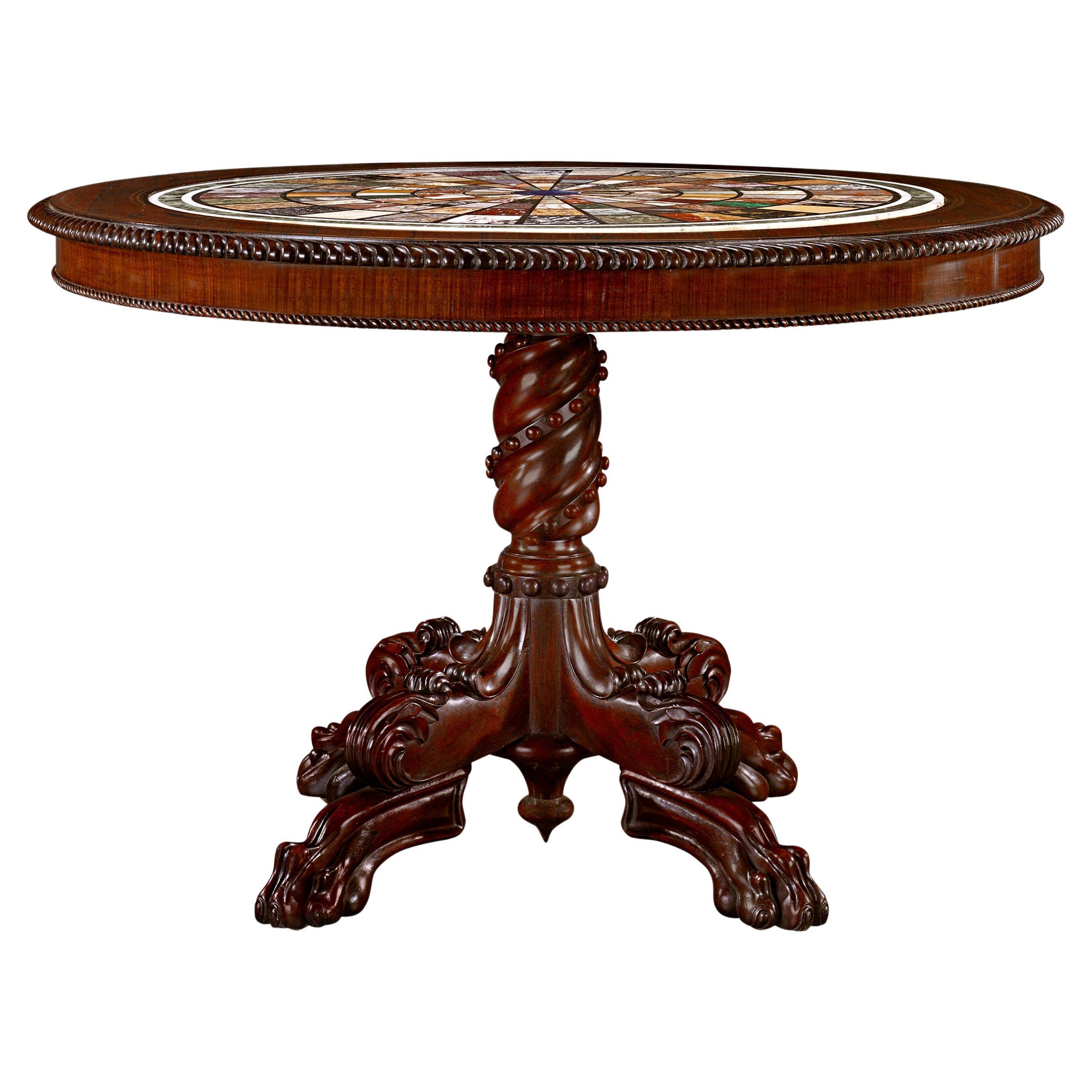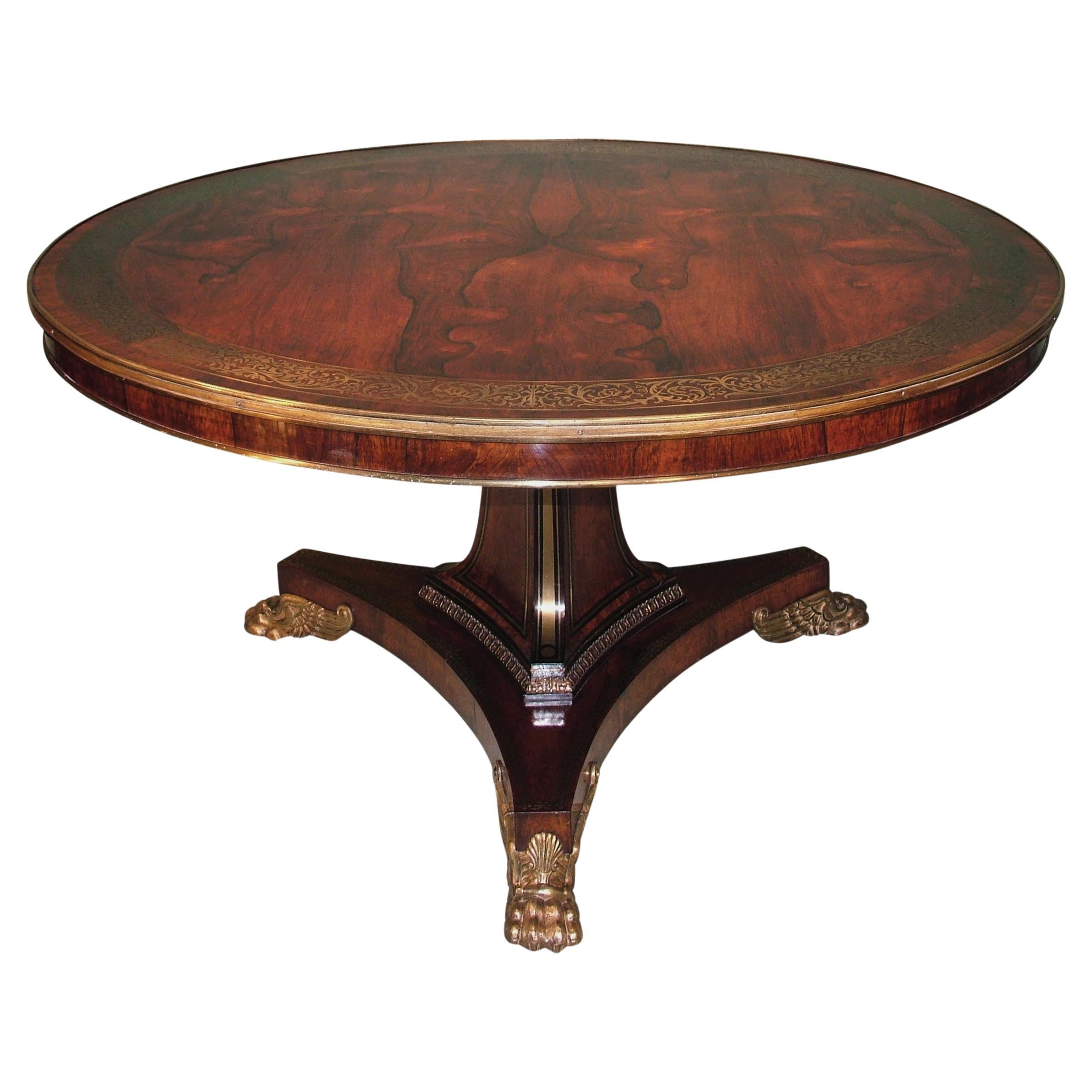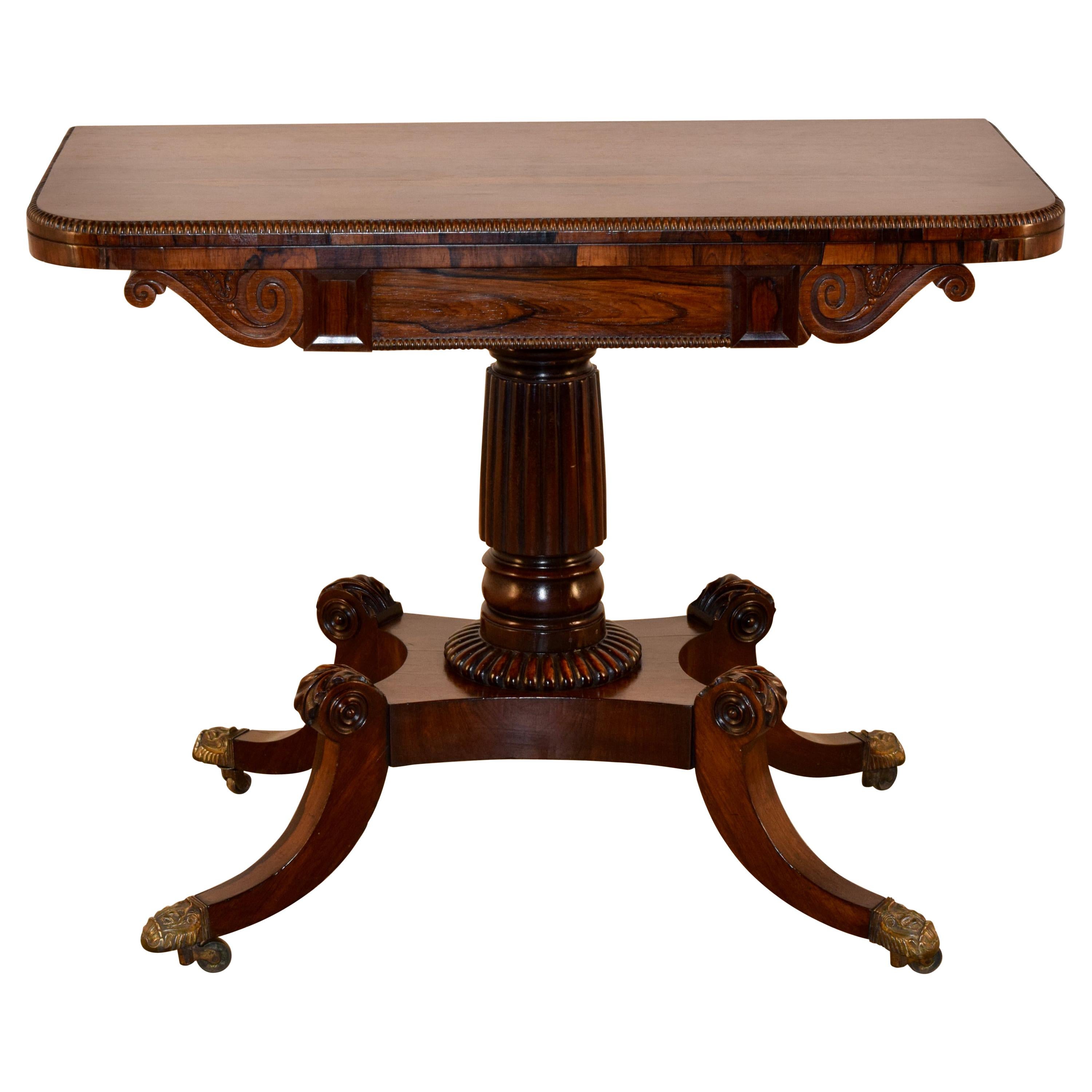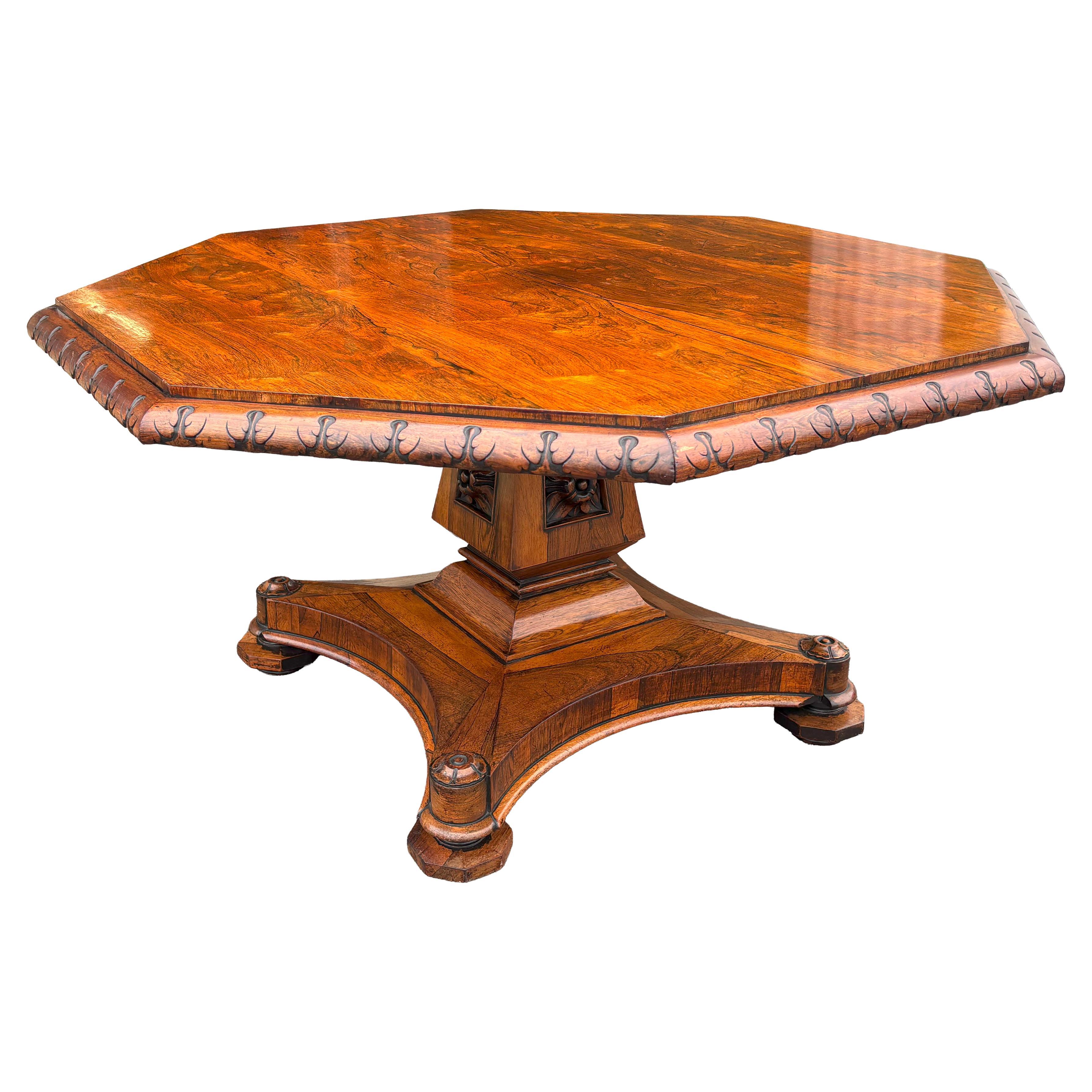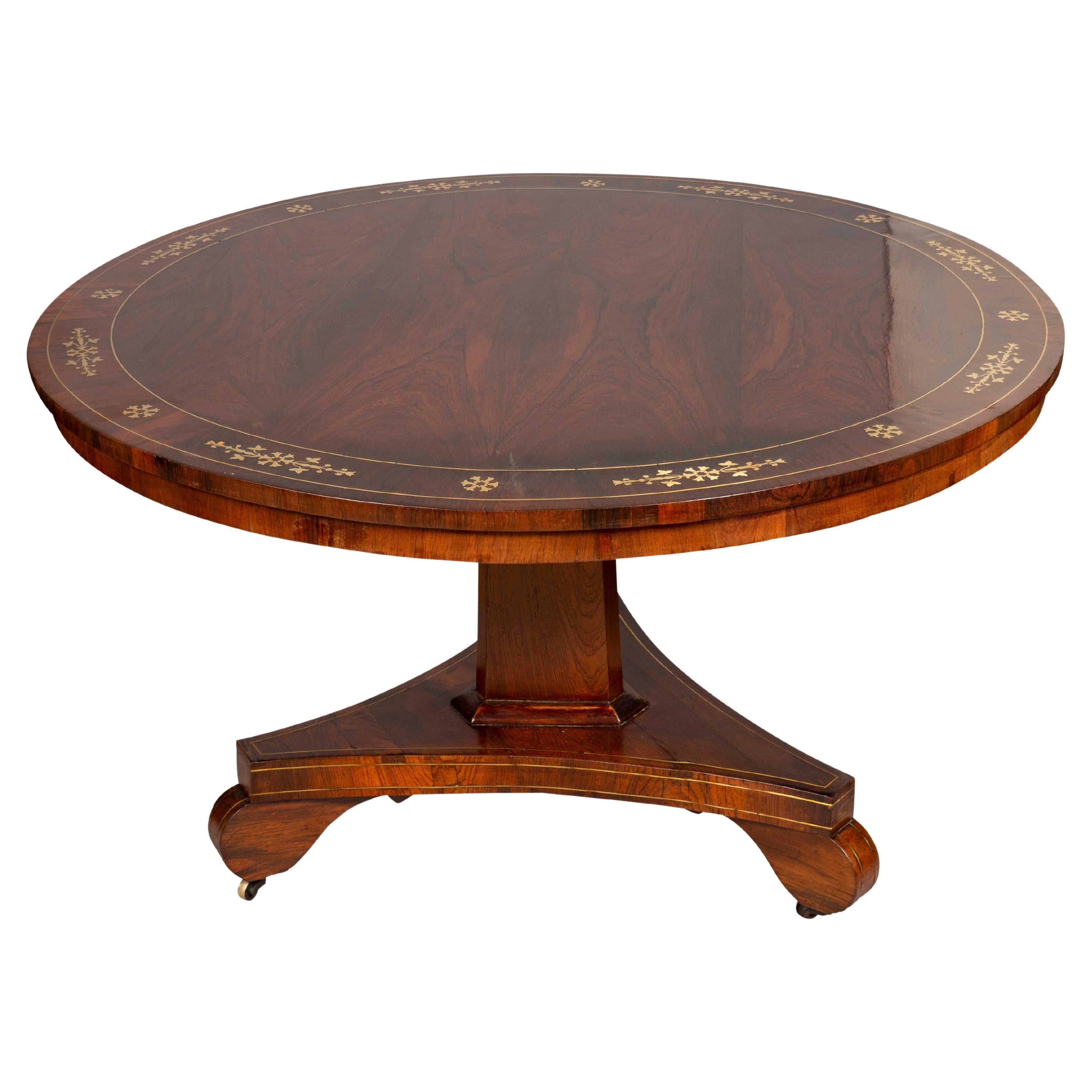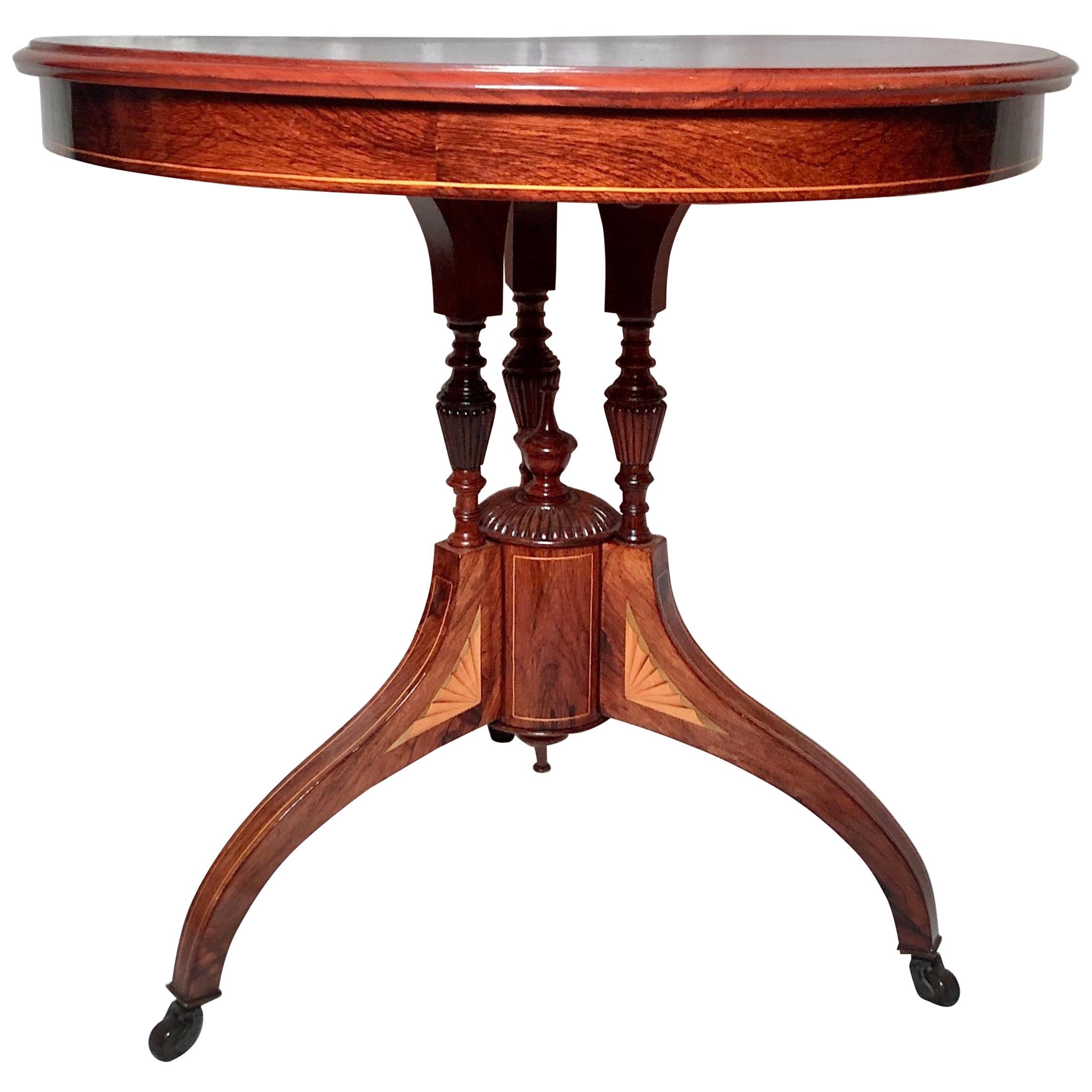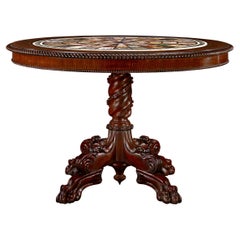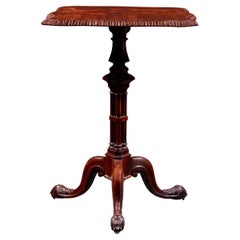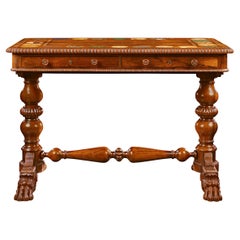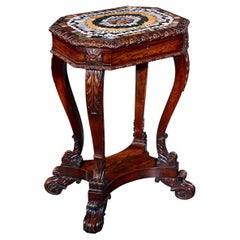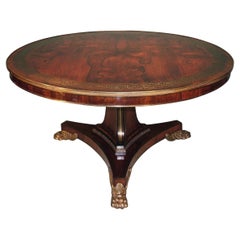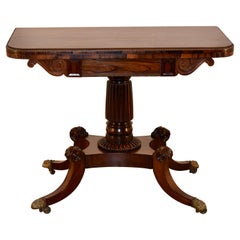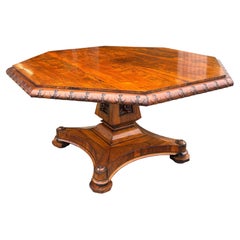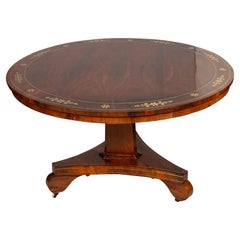Items Similar to 19th Century Rosewood and Pietra Paesina Specimen Table Attributed
Want more images or videos?
Request additional images or videos from the seller
1 of 5
19th Century Rosewood and Pietra Paesina Specimen Table Attributed
$198,500
£151,622.90
€174,231.91
CA$283,360.21
A$310,682.12
CHF 162,235.77
MX$3,738,669.29
NOK 2,044,723.07
SEK 1,922,565.63
DKK 1,301,189.65
About the Item
Pietra Paesina is one of the most scarce and wondrous stones on earth, and the surface of this exceptional early 19th-century center table is inset with one of the rarest and most monumental examples of the natural wonder known to exist. The stone resides in this majestic rosewood creation attributed to the renowned firm of Gillows of Lancaster and London, the favourite furniture makers of nobility and royalty throughout England. From the amazing patterning of the precious Pietra Paesina to the magnificent carved central column and lion’s paw feet, this table evokes a sense of luxury and privilege.
Pietra Paesina
Pietra Paesina, also known as "ruin marble" and "landscape marble", hails primarily from the Northern Apennine mountains near Florence, Italy. The stone is believed to have formed approximately 40 to 50 million years ago under very rare and precise geological conditions whereby limestone deposits deep within the Earth became fractured by the movement of tectonic plates. These fractures were then filled over time with iron and manganese hydroxide deposits from groundwater that were later sealed by the deposition of calcite crystals. When cut, these mineral deposits within the stone formed landscape-like images that appear to resemble ancient ruins or mountainous terrains.
This marvelous stone was discovered sometime in the 16th century and immediately became desired by royalty and wealthy connoisseurs around the world, with the first being the royal Medici of Renaissance Italy who had Florentine artisans Craft furniture and interior ornaments to adorn their palaces. Finding large specimens of Pietra Paesina as displayed in this center table is nearly impossible since most known examples are small enough to fit in your hand. The stone must be cut in order to see if the desired patterning is present, which is not guaranteed. If a pattern is present, by the time it is cut and polished, very little of the stone remains, making the top of this table a true marvel of the natural world.
The Table
Gillows furnishings are held in the highest regard and the opportunity to acquire a one-of-a-kind masterpiece by this esteemed company is indeed a rarity. Hardstone pieces such as this were popular among the British aristocracy during the 19th century, as they displayed the wealth and worldly knowledge of those that owned them. Such hardstones were often acquired by those participating in their Grand Tour of Europe and would be brought back and incorporated into some of the finest furnishings of the period, so there is little wonder why a firm such as Gillows would have been commissioned for such an important work.
Founded in 1703 by Robert Gillow, the Gillows firm operated successfully as a family-owned business well into the 19th century. Originally operating from Lancaster, England, Gillows was especially noted for their quality of workmanship and innovative designs. No other firm in the country had managed to gain as far-reaching and prestigious a level of patronage than that of the Gillows firm, primarily due to the quality and Classic nature of their furnishings. The Gillows firm was especially popular with the English nobility and with powerful religious figures throughout the country. Clients included the Earls of Wilton, the Duke of Norfolk, the Earl of Surrey and the Archbishop of York.
Made by one of the most famed furniture makers of the 19th century with one of the rarest stones in the world, this center table is a masterpiece of furniture making worthy of a museum.
circa 1820
Provenance:
Hailing from an important English titled estate where it has been since it was commissioned.
Measures: 36" diameter x 29" high.
- Attributed to:Gillows of Lancaster & London (Maker)
- Dimensions:Height: 29 in (73.66 cm)Diameter: 36 in (91.44 cm)
- Style:Regency (In the Style Of)
- Materials and Techniques:
- Place of Origin:
- Period:
- Date of Manufacture:circa 1820
- Condition:
- Seller Location:New Orleans, LA
- Reference Number:Seller: 30-87151stDibs: LU891114359482
About the Seller
5.0
Recognized Seller
These prestigious sellers are industry leaders and represent the highest echelon for item quality and design.
Established in 1912
1stDibs seller since 2010
112 sales on 1stDibs
Typical response time: 8 hours
- ShippingRetrieving quote...Shipping from: New Orleans, LA
- Return Policy
Authenticity Guarantee
In the unlikely event there’s an issue with an item’s authenticity, contact us within 1 year for a full refund. DetailsMoney-Back Guarantee
If your item is not as described, is damaged in transit, or does not arrive, contact us within 7 days for a full refund. Details24-Hour Cancellation
You have a 24-hour grace period in which to reconsider your purchase, with no questions asked.Vetted Professional Sellers
Our world-class sellers must adhere to strict standards for service and quality, maintaining the integrity of our listings.Price-Match Guarantee
If you find that a seller listed the same item for a lower price elsewhere, we’ll match it.Trusted Global Delivery
Our best-in-class carrier network provides specialized shipping options worldwide, including custom delivery.More From This Seller
View AllRegency Rosewood Marble Specimen Table
Located in New Orleans, LA
This exquisite Regency-period rosewood table is distinguished by its remarkable specimen top. An exceptional relic of natural history, the tabletop, created circa 1840, bears nearly ...
Category
Antique 19th Century English Regency Tables
Materials
Lapis Lazuli, Porphyry, Siena Marble, Griotte Marble, Carrara Marble, Ma...
Victorian Rosewood Table
Located in New Orleans, LA
Rosewood Table
Circa 1890
This exquisite Victorian table is crafted from luxurious rosewood, a highly prized material known for its rich grain and warm hues. The elegantly carved tr...
Category
Antique 19th Century Victorian End Tables
Materials
Rosewood
$6,850
Hardstone and Rosewood Centre Table Attributed to Gillows
By Gillows of Lancaster & London
Located in New Orleans, LA
This remarkable rosewood centre table attributed to legendary firm Gillows showcases masterful craftsmanship and stunningly rare hardstone specimens. The table's base is ornately crafted, complete with lion's paw feet, emphasizing the quality of the wood. The most impressive element of this beautiful piece of furniture, however, is the exquisite inlaid table top. Featuring eighteen semi-precious and hardstone specimens artfully arranged in alternating geometric shapes, rare stones like gem quality Lapis Lazuli, Egyptian porphyry and Siberian amethyst dazzle the eye. Other stones and specimens inlaid in square, circle and hexagon shapes include pyrite lapis lazuli, malachite, green aventurine, agate of amethyst, greek spartan porphyry, labradorite, fossilized wood, occhio di pavone, brèche verte d'égypte, sicilian jaspers, blood stone, spanish brocatelle, siena brocatelle, convent siena and nero antico. The sheer variety and superb quality of these features is an overwhelming visual delight and a triumph of craftsmanship.
Hardstone pieces such as this were popular among the British aristocracy...
Category
Antique 19th Century Regency Center Tables
Materials
Agate, Amethyst, Lapis Lazuli, Malachite, Porphyry
Specimen Table Attributed to William Trotter
By William Trotter
Located in New Orleans, LA
Octagonal Specimen Table
William Trotter
Early 19th Century
This extraordinary early 19th-century Scottish specimen table is a museum-quality masterpiece attributed to William Trott...
Category
Antique Early 19th Century Scottish Regency Side Tables
Materials
Agate
19th Century Exhibition Model of Expanding Table by Samuel Hawkins
By Samuel Hawkins
Located in New Orleans, LA
A masterpiece of both cabinetmaking and mechanical engineering, this one-of-a-kind expanding table was crafted by the renowned cabinetmaker Samuel Hawkins of London for the Great Exhibition of 1851. Diminutive in size, the fascinating table was designed as a model to demonstrate Hawkins’ innovative patent screw movement to visitors of the Exhibition – six million people in total over five months. It was exhibited again a century later at the Victoria & Albert Museum during the Festival of Britain, an event intended “to symbolise two main qualities of the national character: realism and strength on the one hand, and, on the other, independence and imagination” (Catalogue of the Exhibition, 1951, p.117). To this day, the miniature masterpiece demonstrates the quest of English furniture makers to combine technical innovation with superb craftsmanship.
Displaying exceptional ingenuity, Hawkins’ wind-out screw mechanism allowed one to extend the table’s base to accommodate concentric leaves with the simple crank of a handle. It is based on the inventive expanding table originally designed by Robert Jupe in 1835, which used a swivel mechanism to separate sections of the tabletop and allow for segmented leaves to be inserted. Hawkins’ tabletop, on the other hand, extends outwards directly from the center in order to accommodate additional leaves around its diameter. This unique design allowed the mechanism to also smoothly operate on rectangular tables, which could be wound out from the middle to allow for more table space.
Hawkins was not alone in his endeavor to combine the technical merits of engineering and mechanics with the most artful pursuit of cabinetmaking. The first half of the 19th century saw a prolific increase in the popularity of applying new ideas to traditional furniture principles, which allowed furniture to serve many purposes. The resulting “patent” furniture was practical and refined, though few were as innovative as Hawkins’ prodigious design.
Carved with the year of the Exhibition on the beautifully designed pedestal base, the table is a testament to the significance of this innovation. The model is mentioned in detail in the catalog of the Great Exhibition of 1851, the first international exhibition of industry, manufacturing, and science. Held at London’s dazzling Crystal Palace, its visitors were treated to exhibits from around the globe, including feats of engineering, innovations in industry, and marvels of design. Queen Victoria herself was a frequent visitor, along with her husband, Prince Albert, and others including Charlotte...
Category
Antique 19th Century English Other Tables
Materials
Mahogany
Regency Rosewood Card Tables
Located in New Orleans, LA
These exceptional late Regency card tables were designed with both elegance and functionality in mind. Crafted of rosewood after a model by Henry Holland, the calamander-banded and g...
Category
Antique 19th Century English Regency Card Tables and Tea Tables
Materials
Rosewood
$44,500 / set
You May Also Like
Early 19th Century Regency Rosewood and brass mounted Centre Table
Located in London, GB
A fine quality early 19th century Regency period rosewood centre table, having intricate brass inlaid and brass edged circular top, raised on ebony and brass paneled triangular conca...
Category
Antique Early 19th Century British Regency Center Tables
Materials
Brass
19th Century English Rosewood Game Table
Located in High Point, NC
A fine 19th century rosewood game table from England. The curved front has a hand beaded edge and wonderfully grained as well. The table top is constructed ingeniously to fold open a...
Category
Antique 19th Century English Victorian Card Tables and Tea Tables
Materials
Rosewood
Early Victorian Rosewood Center Table
Located in Essex, MA
With a thick octagonal top with stylized leaf carved edge supported on a square tapered support with carved flower and leaves. The concave sided base with octagonal bun feet.
Category
Antique 1840s English Early Victorian Center Tables
Materials
Rosewood
Regency Rosewood and Brass Inlaid Center Table
Located in Essex, MA
With a circular hinged top with brass inlaid border supported on a triangular support ending on a conforming base with brass stringing and raised on plain Greek form feet. Casters.
Category
Antique 1830s English Regency Center Tables
Materials
Brass
Antique English Victorian Rosewood Table with Inlay, Circa 1860- 1870
Located in New Orleans, LA
Antique english Victorian rosewood table with inlay, Circa 1860- 1870.
Category
Antique Late 19th Century English Victorian Tables
Materials
Rosewood
French 19th century Charles X Period Mahogany, Rosewood and Maple center table
Located in West Palm Beach, FL
A high quality and most handsome French 19th century Charles X Period Mahogany, Rosewood, Maple and Brass center table. This most decorative table is supported on a tripod base with ...
Category
Antique 19th Century French Charles X Center Tables
Materials
Brass
More Ways To Browse
Lions Paw Table
Lion Feet Table
Gillow Rosewood
Lion Paw Feet Table
A Regency Specimen Marble Table
French Marquetry Center Tables
Jaime Hayon Explorer
Paw Foot Furniture
Pietra Dura Table Top
Acanthus Pedestal
Carved Lion Table
Empire Round Table
Marquetry Centre Table
Oak Centre Table
Rosewood Centre Table
Sunburst Veneer
Bronze Centre Table
Empire Style Center Table
